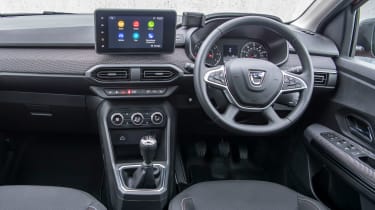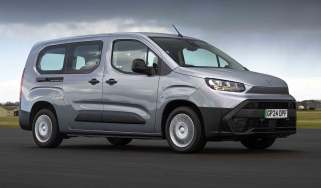Dacia Jogger 1.0 TCe Extreme SE 2022 review
The new Dacia Jogger is a great car, with no rival able to come to close to its level of versatility at this price point

Verdict
It’s no surprise that the Dacia Jogger is great value for money, but consider the staggering versatility it offers for such a low price and no other new car even comes close. Whether you choose to use it as a full seven-seater, or ditch the back seats to turn it into a huge estate car, it does a brilliant job of filling either role. It may be basic, but it’s even decent enough to drive. Following years of car manufacturers sticking to a tried and tested family-car formula, the Jogger has come along and transformed the category in one huge step.
It's not often that a new car takes us by surprise – when something we’ve seen on the horizon perhaps intrigues, or delights, or (occasionally) disappoints in a way we weren’t expecting. But in the case of the Dacia Jogger, we’re almost lost for words.
When a car tries to be too many things, it frequently falls short of mastering any of the various briefs set out for it, instead sitting awkwardly between several categories without nailing any of them.
Approach the rather odd-looking Jogger and you fear it might be due the same fate. Is it an estate? A traditional MPV? And is there a bit of SUV thrown in there? The Romanian brand will tell you that it’s a bit of all three.
Used - available now

2023 Dacia
Jogger
14,482 milesManualPetrol1.0L
Cash £16,300
2024 Dacia
Jogger
10,227 milesManualPetrol1.0L
Cash £14,400
2023 Dacia
Jogger
21,035 milesManualPetrol1.0L
Cash £15,733
2023 Dacia
Jogger
21,751 milesManualPetrol1.0L
Cash £15,053In this case, though, the Jogger really has nailed what it set out to achieve - and has managed it at a quite staggering price.
Let’s start with the basics, then. Under the skin, the Jogger is derived from the same CMF-B architecture as Dacia’s Sandero supermini - and therefore also our favourite small car, the Renault Clio. It shares a similarly stubby bonnet to the Sandero, and beneath it sits a variation of that car’s 1.0-litre three-cylinder turbocharged engine. Here it produces 108bhp and 200Nm of torque.
From the bonnet back, things start to look a little quirky. While there’s some chunky plastic cladding and a reasonable amount of ground clearance to tick the SUV boxes, the look is mainly there to maximise this car’s trump card: practicality. The CMF-B platform has been stretched 459mm further than the Sandero’s, to make a car measuring 4,547mm in length. But the Jogger still isn’t ungainly; in fact, that means it takes up just a tiny bit more space on the road than a Honda Civic.
Look at the car in profile and you’ll notice quite a pronounced step up in the roof line at the B-pillar - 40mm, to be precise. This combines with a near-vertical drop off at the back end to really maximise a modest footprint to the benefit of cabin space.
As a result, the Jogger seats seven. And we’re not talking about two parents up front and five small kids further back; all three rows have enough space for adults. The middle row offers similar knee room to a Volkswagen Golf, but offers considerably more foot room and headroom. There’s a genuinely comfortable centre seat, too, so it’s more than comfy enough for three people.
Pull a little loop on the top of the seat back and the seat folds forward to give access to the back row. It’s a touch tighter for head and knee room than in the middle, but it’s still more comfy back there than significantly larger seven-seaters like the Skoda Kodiaq and Land Rover Discovery Sport. There’s still a modest 212-litre boot in this seating arrangement, too.
Don’t need seating for seven? Fold them away and there’s a vast 699-litre boot. They can even be removed altogether - at 10kg each, they’re not too bulky - and you’ll have even more space.
Once you’ve exhausted all of that storage - plus the 23 litres of internal cubbies, it’s time to make the most of the storage potential outside. The Jogger is available with a modular roof rack; using an Allen key supplied with the car, the bars can be unscrewed and rearranged to form strong cross braces, which can hold up to 80kg.
As for the driving, it’s really not bad at all, considering its purpose. At just over 1,200kg, it’s very light by seven-seater standards, so it feels quite nippy. The suspension is soft, so there’s a decent amount of roll through corners, but it’s significantly better to drive than any van-based MPV. It’s also fairly relaxing at a cruise; the peace on a motorway is only interrupted by quite pronounced wind noise from around the door mirrors.
Likewise, that engine gives strong performance. Admittedly, this will take a hit when loaded with seven people, but the useful dose of low-down torque means that it’ll get up to motorway speeds just fine, even when fully laden. A hybrid model is due next year, which should not only cater for those who want more power (it’ll offer 138bhp) but also improve on the 44mpg we managed in this 1.0-litre petrol - especially when driving in town.
There are some minor flaws with the Jogger’s versatility. For a seven-seater, it would’ve been nice to have more than just two Isofix points - even one in the front passenger seat would give parents more child seat options - and the infotainment screen needs to be manually dimmed at night via a settings menu. It’s distractingly bright otherwise.
But then you remember that this is a Dacia, take one look at the price list, and those small negatives can be forgiven quite easily. The Jogger starts from £14,995 in base Essential trim, which features air conditioning, rear parking sensors, cruise control and auto headlights as standard. Based on a PCP finance deal, it’s possible to put £196 down up front, and pay £196 per month for four years.
If you can up the budget to £16,595 (or £215 per month, with a £215 deposit, on the same PCP terms) then we’d recommend the Comfort. This adds the modular roof bars, a touch screen with Android Auto and Apple CarPlay, front parking sensors, a reversing camera and a few other extras.
The top-of-the-line Extreme SE that’s pictured here gets alloy wheels, heated front seats and a built-in navigation system that isn’t as good as the one built into your smartphone anyway, so while it’s still not exactly pricey, with a deposit/monthly rate of £225, we’d keep hold of those 49 tenners.
Finding another new car that seats seven for anywhere near that price is impossible. Even doubling the price of the Essential still makes it tricky. A SEAT Tarraco, which is admittedly more powerful and posher inside, costs from £30,785. Even a (five-seat) estate car with this much space, like the Skoda Octavia, will set you back at least £23,250.
| Model: | Dacia Jogger Extreme SE Tce 110 |
| Price: | £17,395 |
| Engine: | 1.0-litre 3cyl petrol turbo |
| Power: | 108bhp/200Nm |
| Transmission: | Six-speed manual, front-wheel drive |
| 0-62mph: | 11.2 seconds |
| Top speed: | 114mph |
| Economy/CO2: | 47.1 mpg/ 131g/km |
| On sale: | Now |













